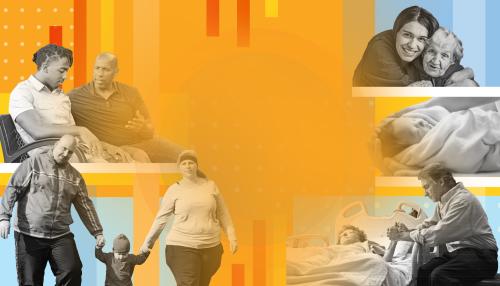“Social capital” is a protean term, meaning different things to different people at different times. In general, it is seen as a measure of community strength, as well as a measure of prevailing norms and culture.
Robert Putnam, the scholar who put social capital on the map, defines it thus in his essay Bowling Alone: America’s Declining Social Capital:
“Features of social organization such as networks, norms, and social trust that facilitate coordination and cooperation for mutual benefit” (Putnam, 1995).
Here are a few other definitions:
“Networks together with shared norms, values and understandings that facilitate co-operation within or among groups” (OECD, 2001).
“Social networks and the norms of reciprocity and trustworthiness that arise from them” (Putnam again, but in 2001).[i]
“The information, trust, and norms of reciprocity inhering in one’s social networks” (Woolcock, 1998).
“Naturally occurring social relationships among persons which promote or assist the acquisition of skills and traits valued in the marketplace” (Loury, 1992).[ii]
There is an important distinction in many of these definitions between norms and networks, or between attitudes and action. These may be related, but they are not the same thing. It is important to be clear in what sense social capital is being conceptualized, defined, and measured before drawing any conclusions, especially for policy.
Networks of various kinds may be valuable in and of themselves, given that humans are social creatures, but they may also facilitate access to other kinds of goods, including some that may be important for opportunity. In this sense, social capital can be seen as both an intrinsic and instrumental good: but then we need to know in which sense it is being used by specific analysts or policymakers. Why do we care about social capital? What benefits is it bringing? What does it cost (in terms of time, for example)?
Relational social capital versus Emotional social capital
A major new survey, the AEI Survey on Community and Society, usefully highlights some of the nuances and distinctions in the use of the term social capital.
The first report of the survey’s findings, Social Capital, Civic Health, and Quality of Life in the United States, published in February 2019, suggests that attitudes towards neighbors and local communities are quite positive overall. Three in four Americans (73%) are satisfied with the way things are going in their communities, compared to 43% who feel the same way about the nation as a whole. (This is a standard local versus global finding in these kinds of surveys: one of my favorites is on the state of marriage in the American Family Survey, showing that people think their own marriage is strong while marriages in general are falling apart. There are also high levels of trust reported.)
Large majorities report that people in their neighborhoods get on well (82%) and are willing to help each other (75%). But much lower proportions say that they themselves talk to their neighbors at least weekly (51%) or that neighbors actually help each other at least weekly (12%):
Whether people say that people get along well, or that people are helpful to each other may tell us something about the general mindset of the respondents, but it seems to tell us rather little about their modes of living.
Hence the gap between how people feel about their neighborhood and how people act in them. Of course, people feeling good is important. But people doing good is more so.
It might be useful to think of this feeling-based variant as “emotional social capital,” distinct from an action-based “relational social capital,” which is of the kind that “facilitates coordination” in Putnam’s terms.
Bridging before bonding social capital, please
Another important distinction is between “bonding” and “bridging” social capital. Bonding takes place within existing communities, including neighborhoods (the focus of the AEI survey). Bridging social capital links people from different communities. As a general rule, we are likely to favor both kinds. But in terms of promoting greater equality or opportunity, we should be seeking bridging social capital which connects people in opportunity-poor neighborhoods to those in opportunity-rich ones.
The increased economic segregation of our communities makes these bridges even more important. We need more than ever the kind of social capital that connects less advantaged people to power, resources, and opportunities from which they are otherwise excluded— “mobility-enhancing social capital,” in the words of my colleague Camille Busette.
Rich networks of bonding social capital in affluent communities may in fact be bad news for opportunity, in the sense that they will promote the interests only of those on the inside. At worst, they may even be used as exclusionary mechanism—for example, by effectively organizing opposition to more inclusionary zoning or school admissions policies.
Social capital for equality
Social capital can act, then, either to enhance or dilute equality. As Ryan Streeter from AEI puts it in a new piece in National Affairs: “How much can wage subsidies, improved career- and technical-education programs, or even college access accomplish if people do not possess the relationships, social networks, and abilities that allow them to take advantage of opportunity? Without relational networks that can help guide and connect us to others whose help we need, and who need us, even the best public policy will have limited effects.”
This is well put. Social capital promotion should not be seen as an alternative to public policy, but as an amplifier. So what are we talking about here? Good examples of bridging, opportunity-enhancing, relational social capital initiatives include:
1) Mentoring programs, such as Big Brothers, Big Sisters.
2) Work-based learning opportunities, especially for students from poorer backgrounds in professional workplaces.
3) “Twinning” partnerships between schools, churches, or other institutions, connecting rich and poor neighborhoods.
It should be said that evaluating the impact of social capital initiatives is difficult, and the attempt is all too rarely made. The task is made even more difficult by a lack of clarity in what kind of social capital is being aimed for, and to what end. From an opportunity perspective, social capital is not about feeling good. It is about doing good.
[i] Putnam RD. Social Capital: Measurement and Consequences. Isuma: Canadian Journal of Policy Research [Internet]. 2001;2 (Spring 2001) :41-51
[ii] Loury, G. (1992). The economics of discrimination: getting to the core of the problem. Harvard Journal for African American Public Policy, 1, 91–110.
The Brookings Institution is committed to quality, independence, and impact.
We are supported by a diverse array of funders. In line with our values and policies, each Brookings publication represents the sole views of its author(s).







Commentary
Feeling good or doing good? Emotional social capital versus relational social capital
April 8, 2019